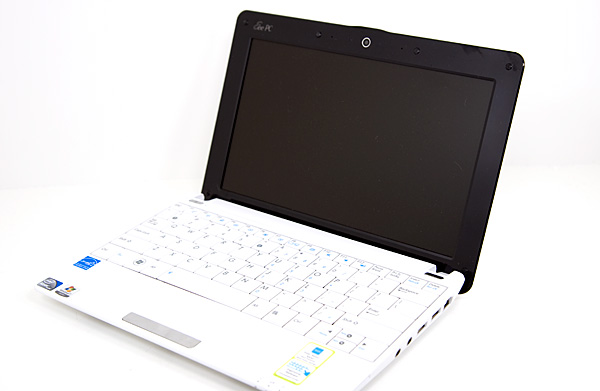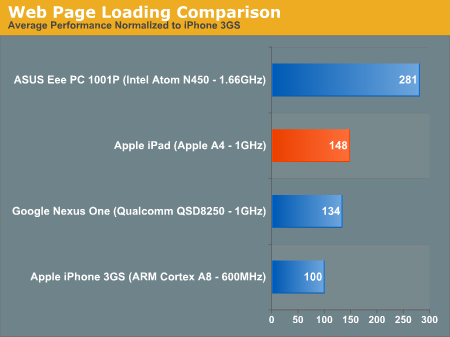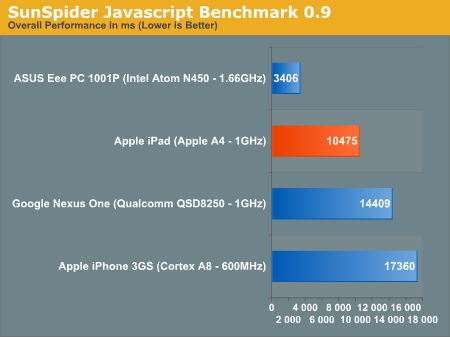Apple's iPad - The AnandTech Review
by Anand Lal Shimpi, Brian Klug & Vivek Gowri on April 7, 2010 9:39 PM EST- Posted in
- Smartphones
- Mac
- Apple
- iPad
- Mobile
The iPad and its Performance
Apple knows how to make things feel fast. It’s all about making animations as smooth as possible and making sure that the UI always responds consistently. Apple isn’t perfect in this regard, but it does pay more attention to detail here than most other companies.
On the iPhone, scrolling is always smooth, swiping between home pages feels quick, apps launching are always well animated. The same is (mostly) true for the iPad, but thanks to a faster processor, many of these animations are physically faster. Bringing up the home screen is lightning quick, as is swiping between them. Scrolling is also very smooth, so much in fact that I found myself scrolling through emails and pages just because the animation was done very well.
There are some rough edges of course. While swiping between home screens is nice and fast, bringing up the quick search screen is choppy (not Android choppy, but choppy for the iPhone OS). The same is true for some other apps, particularly 3rd party ones. The latter point makes sense given that developers haven’t had much time with the device, but Apple not ensuring a perfectly smooth UI across the entire OS is telling.
Apple tends to move engineering resources around the company. The iPhone launch delayed the OS X launch that same year. And the iPad launch surely had some impact on other products. Or is it the other way around? Later this week we’ll see Apple preview version 4 of the iPhone OS, which implies a release sometime in the coming months (June?). An on-track iPhone OS 4 release could explain some rough edges with the shipping iPad, as well as why we don’t seem to have a plethora of amazing apps from Apple at launch.
Despite my nitpicking, this thing is definitely faster than the iPhone 3GS and even the Google Nexus One. Surfing the web, loading applications or generally just interacting with the device. Going to a 3GS from a Nexus One feels slow, going to a 3GS after using the iPad just feels wrong.
But with a larger screen you get the desire to want to do more and expect more from the iPad. I would say that in this sense the performance is a letdown. The A4 is speedy but not quite fast enough for this size of device.
| iPad (Apple A4) | Google Nexus One (Qualcomm QSD8250) | iPhone 3GS (ARM Cortex A8) | iPhone 3G (ARM11) | |
| Manufacturing Process | 45nm | 65nm | 65nm | 90nm |
| Architecture | In-Order | In-Order | In-Order | In-Order |
| Issue Width | 2-issue | 2-issue | 2-issue | 1-issue |
| Pipeline Depth | ??-stage | ??-stage | 13-stage | 8-stage |
| Clock Speed | 1GHz | 1GHz | 600MHz | 412MHz |
| L1 Cache Size | ?? | ?? | 32KB I-Cache + 32KB D-Cache | 16KB I-Cache + 16KB D-Cache |
| L2 Cache Size | ?? | ?? | 256KB | N/A |
| GPU | PowerVR SGX | Adreno 200 | PowerVR SGX | PowerVR MBX |
To figure out where the iPad falls in the grand scheme of things I ran a number of web page load tests and browser benchmarks. To remove the internet from the equation, I loaded all pages off of a server on my own network. This is as close to a pure CPU and OS/browser benchmark as we’ll get.
Given that the iPad runs off smartphone hardware, the obvious comparisons are the iPhone 3GS and Google’s Nexus One. The former is based on a 600MHz Cortex A8, while the latter uses Qualcomm’s 1GHz Snapdragon QSD8250 running Android. Oh and there’s just one more thing:

This is ASUS' Eee PC 1001P. Priced below $300 it is the epitome of the netbook. Low cost and functional, but without looking overly cheap. Based on Intel’s Atom N450 processor this should put things in perspective. I ran the same set of benchmarks on it that I ran on the rest of the platforms. I used Chrome running on Windows 7.
| Apple iPhone 3GS | Google Nexus One | Apple iPad | ASUS Eee PC 1001P | |
| AnandTech Front Page | 4.5s | 4.3s | 3.1s | 1.2s |
| CNN Front Page | 5.4s | 4.4s | 3.9s | 2.8s |
| CNN Front Page 3 | 8.7s | 6.8s | 6.3s | 3.5s |
| 2.5s | 2.4s | 2.0s | 1.4s | |
| MSN | 10.5s | 5.1s | 5.0s | 2.8s |
| Yahoo! | 1.9s | 1.6s | 1.4s | 0.8s |
| Engadget | 15.0s | 11.6s | 11.1s | 4.8s |
To make this data easier to read I averaged all of the numbers for each device, normalized them to the iPhone 3GS (in terms of % faster) and put the data in a graph:

And now you see why I said the A4 does well against smartphones, but doesn’t cut it for the screen size of the iPad. While the iPad is 46% faster than the iPhone 3GS and 14% faster than the Nexus One on average, the Eee PC is 87% faster than the iPad. It is noticeable!
Real world JavaScript performance is also no contest between the A4 and Intel's Atom:

If Apple doesn't have plans to use Moorestown (or a derivitive) in its iPad at some point, I would be sorely disappointed in the company's ability to make intelligent hardware decisions.
I will give Apple credit, the iPad feels quick in most cases, which is probably why the sacrifice to go with a lowly Cortex A8 was made. However, when it comes to browsing the web, there’s a tradeoff. It’s much better reading web pages on the iPad, but it’s much faster on the Eee PC.
The comparison gets more complex when you look at things like application launch times. It takes the iPad 3 seconds to launch Pages, and less than 1 to launch Safari. If the application was previously in memory, the Eee PC can fire up Chrome in less than a second, otherwise it takes longer depending on what Windows decides to do with the disk at that moment. And launching Word from scratch takes much longer than 3 seconds.
Apple is relying on solid state storage and a very lightweight OS while netbooks usually have terribly slow hard drives and a bulky software stack. It’s a ginormous tradeoff. Web pages load quicker on a netbook, but are easier to read/navigate on the iPad.
What Apple absolutely needs in here is an Atom CPU. Apple buys itself a lot of leeway by using a very lightweight OS, but when a web page still takes a dozen seconds to load - you feel the pain. While I realize that Atom hasn't been suited for such an application until now, there's no reason Apple should've picked the A4 over Moorestown. Moorestown can fit in devices far smaller than the iPad, and would make this thing perform more like (and better than in some cases thanks to the OS) a netbook. I laughed when Jobs said that netbooks don't do anything well. While I'd agree a lot of the time, here they do seem to load web pages faster than the iPad.










108 Comments
View All Comments
dagamer34 - Friday, April 9, 2010 - link
Anyone who looks at the raw costs of materials and bases decisions of a product being "overpriced" has never taken Business 101.I'll limit myself to 4 things which that "50-60%" pays for:
1) Running Apple stores and employees
2) Running Apple itself in Cupertino (and worldwide) - employees, board, executives, etc.
3) Apple product support for the first year (phone support, in-person support, etc.)
4) Warranties (i.e. - your iPad breaks in the first year and you complain they should fix it on their dime)
NEVER assume a company gets a "huge" profit when only looking at BOM. That's just idiotic. And it's almost impossible to know how much the points I listed above factor into a product's cost in any great detail without making huge assumptions or pure guesswork.
manicfreak - Friday, April 9, 2010 - link
Doesn't change the fact the profit gained from the iPad is higher than the iPod from the last few years.Overpriced.
GTaudiophile - Thursday, April 8, 2010 - link
That is indeed one of the best episodes of TOP GEAR ever.And then at the end, they all drive home to Sigur Ros playing in the background.
semo - Thursday, April 8, 2010 - link
"There's also an optional VGA output, but I won't point out what issues I have with that."Why?
Anand Lal Shimpi - Thursday, April 8, 2010 - link
I was poking fun at it, I thought it was obvious what my issues with a VGA dongle would be. Especially given that Apple's own products haven't supported VGA in years, and the input is definitely not common on modern HDTVs.It looks like the iPad is missing a TMDS as we don't get any options for digital out (HDMI, DVI, DP). I'll clarify in the article :)
Take care,
Anand
PhilipHa - Thursday, April 8, 2010 - link
You may be interested inhttp://www.brightsideofnews.com/news/2010/4/7/the-...
contains some interesting performance comparisons between x86 and ARM (but not IPAD)
pervisanathema - Thursday, April 8, 2010 - link
You would be much wiser to wait for the inevitable widescreen version with a camera and faster CPU. I guarantee Apple has one in the works and they are simply waiting to screw the early adopters. The 4:3 aspect ratio was obviously picked solely so they would have a compelling reason to force people to buy the next revision.dagamer34 - Friday, April 9, 2010 - link
OR 4:3 works better with books and it's the same ratio as the iPhone?Shadowmaster625 - Thursday, April 8, 2010 - link
You pick a heck of a time to start complaining about apple's app pricing. Of course they are going to charge an arm and a leg for apps. That's what apple does. That's ALL apple does. This device, all told, requires an over $1500 investment for 2 years.iPad $500
Bag $30
10 Apps $120
2 years of service $720
Other accessories $50
Taxes ~$100
Total >$1500
It is a ripoff of epic proportions. It's no faster than a penium III notebook I can buy on ebay for $68. This is outrageous. Are you out of your flippin mind? The real economy is in the middle of a depression. Real private GDP is down close to 20%. By and large, the only people who are going to be able to afford this overpriced garbage are people sucking off the government teat. (Like union trash collectors and station agents who make 6 figure salaries.) Nobody who actually works for a living in the private sector is going to spend $1500 on something like this, not if they wish to remain solvent anyway.
strikeback03 - Friday, April 9, 2010 - link
Umm, your numbers are slightly off. There is no service fee for the WiFi-only $500 iPad. The 3G version starts at $630.Besides that though, I know plenty of people who have the disposable income to buy a toy like this of they wished. Sure it is overpriced, but just as there are consumers who pay $500 and up for video cards ther are some who pay $600-700 for expensive toys like this. It is arguably a better use of money than that $800 netbook Sony came out with last year.